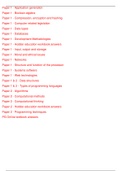Lecture notes
OCR Computer Science (complete set)
A complete set of notes of OCR A-Level Computer Science H446 which I used ot achieve an A*. Also contains answers for the PG Online Textbook and both Hodder Education Workbooks. Please note structure and function of the processor and systems software are hand written but everything else has been ty...
[Show more]




